Mental Health Nursing Assignment: CDU Nursing, Semester 2, 2018
VerifiedAdded on 2023/06/10
|9
|2893
|417
Homework Assignment
AI Summary
This assignment solution addresses a clinical scenario involving a new graduate nurse admitting a 32-year-old patient named Stefan for day surgery. The solution begins by discussing essential communication skills, including active listening, focusing, and open-ended questions, and their importance in building rapport and gathering information. It then analyzes Stefan's presenting symptoms, such as inability to stay calm, panic fear, sleeplessness, and loss of body weight, to support a diagnosis of anxiety. The solution further details the application of relaxation techniques like slow diaphragmatic breathing and visualization to reduce Stefan's anxiety. Finally, it explains the relevant information needed to provide Stefan with regarding a medication order for diazepam, including benefits, warnings, and potential side effects, to help him make an informed decision about his treatment.
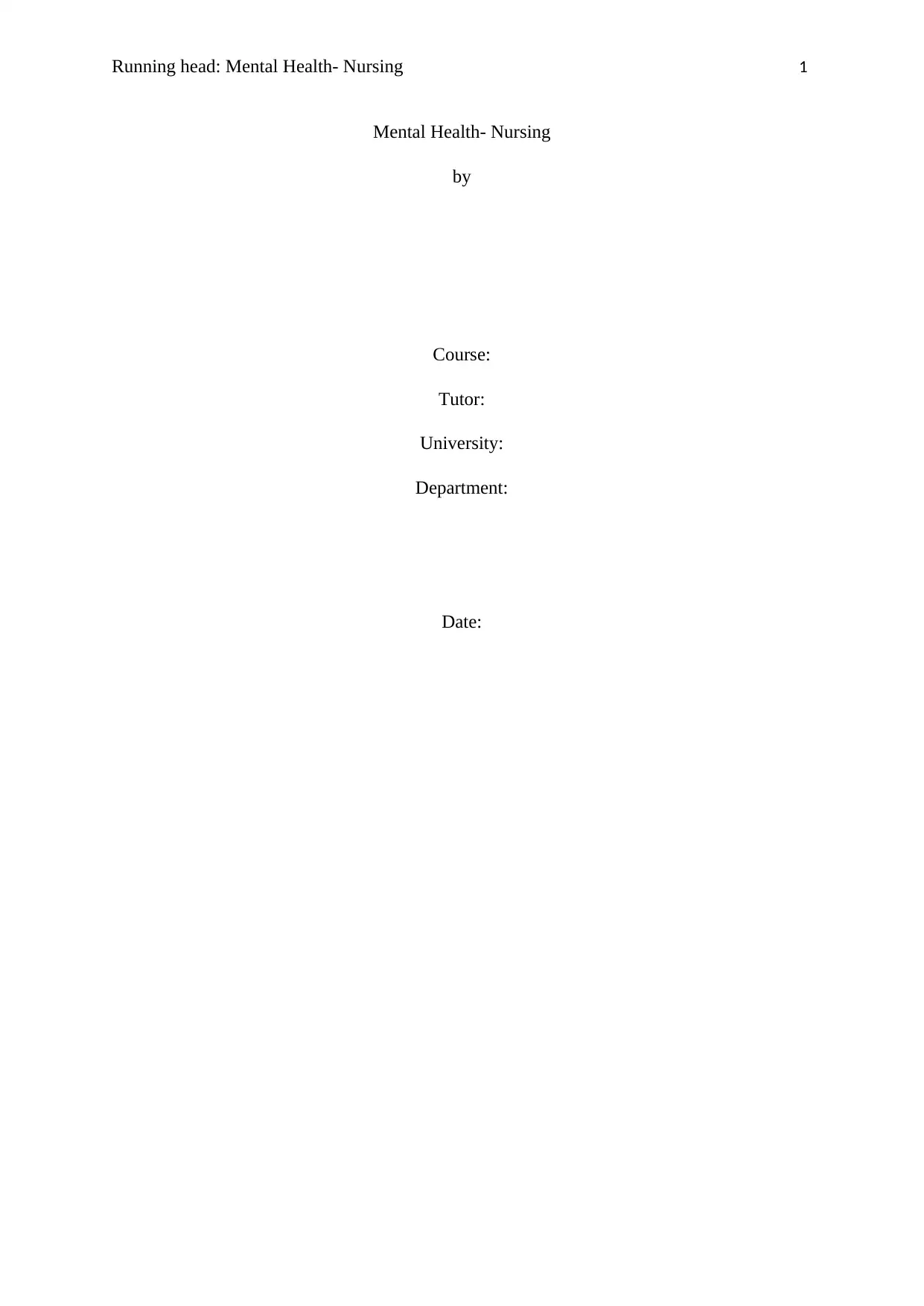
Running head: Mental Health- Nursing 1
Mental Health- Nursing
by
Course:
Tutor:
University:
Department:
Date:
Mental Health- Nursing
by
Course:
Tutor:
University:
Department:
Date:
Paraphrase This Document
Need a fresh take? Get an instant paraphrase of this document with our AI Paraphraser
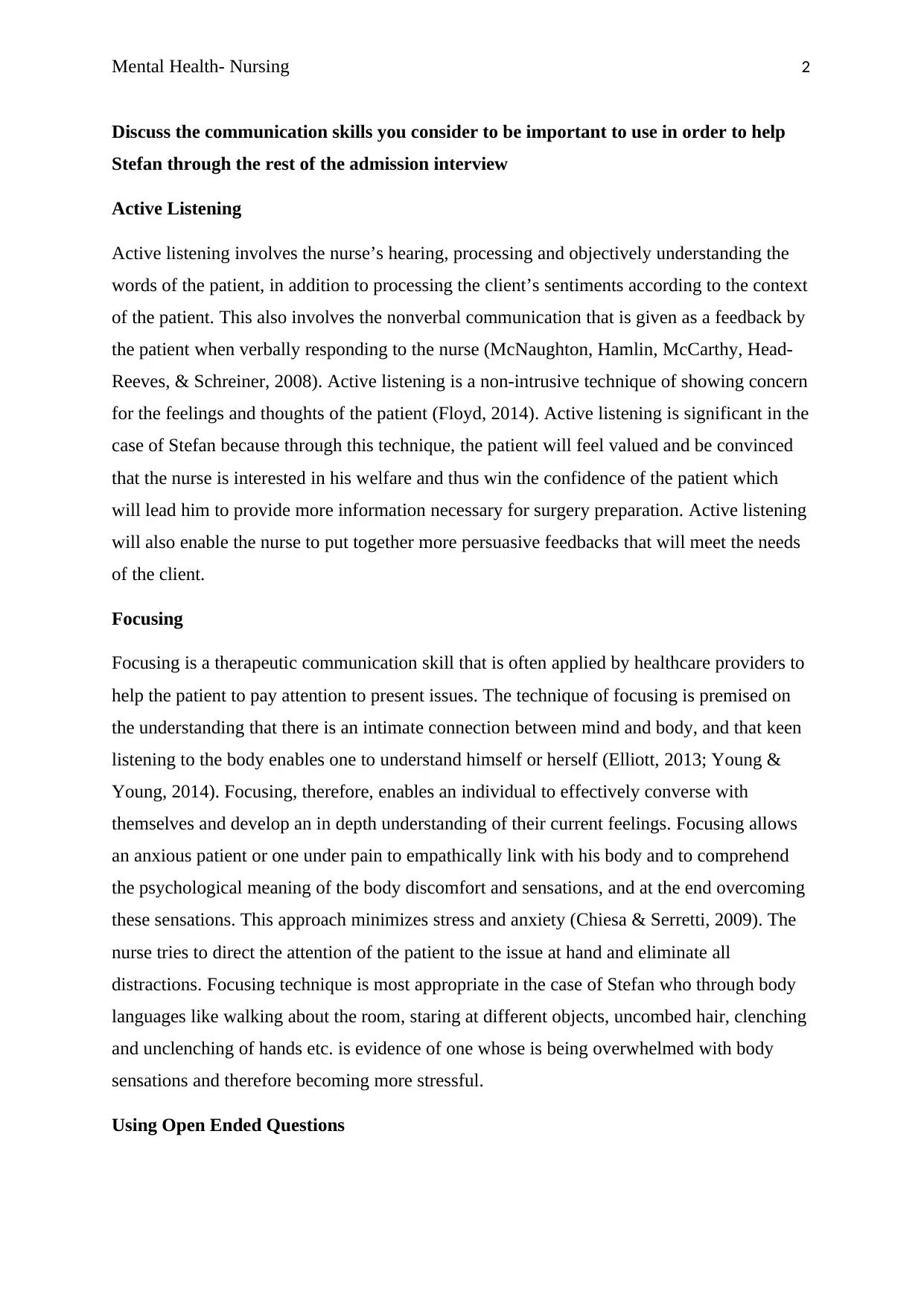
Mental Health- Nursing 2
Discuss the communication skills you consider to be important to use in order to help
Stefan through the rest of the admission interview
Active Listening
Active listening involves the nurse’s hearing, processing and objectively understanding the
words of the patient, in addition to processing the client’s sentiments according to the context
of the patient. This also involves the nonverbal communication that is given as a feedback by
the patient when verbally responding to the nurse (McNaughton, Hamlin, McCarthy, Head-
Reeves, & Schreiner, 2008). Active listening is a non-intrusive technique of showing concern
for the feelings and thoughts of the patient (Floyd, 2014). Active listening is significant in the
case of Stefan because through this technique, the patient will feel valued and be convinced
that the nurse is interested in his welfare and thus win the confidence of the patient which
will lead him to provide more information necessary for surgery preparation. Active listening
will also enable the nurse to put together more persuasive feedbacks that will meet the needs
of the client.
Focusing
Focusing is a therapeutic communication skill that is often applied by healthcare providers to
help the patient to pay attention to present issues. The technique of focusing is premised on
the understanding that there is an intimate connection between mind and body, and that keen
listening to the body enables one to understand himself or herself (Elliott, 2013; Young &
Young, 2014). Focusing, therefore, enables an individual to effectively converse with
themselves and develop an in depth understanding of their current feelings. Focusing allows
an anxious patient or one under pain to empathically link with his body and to comprehend
the psychological meaning of the body discomfort and sensations, and at the end overcoming
these sensations. This approach minimizes stress and anxiety (Chiesa & Serretti, 2009). The
nurse tries to direct the attention of the patient to the issue at hand and eliminate all
distractions. Focusing technique is most appropriate in the case of Stefan who through body
languages like walking about the room, staring at different objects, uncombed hair, clenching
and unclenching of hands etc. is evidence of one whose is being overwhelmed with body
sensations and therefore becoming more stressful.
Using Open Ended Questions
Discuss the communication skills you consider to be important to use in order to help
Stefan through the rest of the admission interview
Active Listening
Active listening involves the nurse’s hearing, processing and objectively understanding the
words of the patient, in addition to processing the client’s sentiments according to the context
of the patient. This also involves the nonverbal communication that is given as a feedback by
the patient when verbally responding to the nurse (McNaughton, Hamlin, McCarthy, Head-
Reeves, & Schreiner, 2008). Active listening is a non-intrusive technique of showing concern
for the feelings and thoughts of the patient (Floyd, 2014). Active listening is significant in the
case of Stefan because through this technique, the patient will feel valued and be convinced
that the nurse is interested in his welfare and thus win the confidence of the patient which
will lead him to provide more information necessary for surgery preparation. Active listening
will also enable the nurse to put together more persuasive feedbacks that will meet the needs
of the client.
Focusing
Focusing is a therapeutic communication skill that is often applied by healthcare providers to
help the patient to pay attention to present issues. The technique of focusing is premised on
the understanding that there is an intimate connection between mind and body, and that keen
listening to the body enables one to understand himself or herself (Elliott, 2013; Young &
Young, 2014). Focusing, therefore, enables an individual to effectively converse with
themselves and develop an in depth understanding of their current feelings. Focusing allows
an anxious patient or one under pain to empathically link with his body and to comprehend
the psychological meaning of the body discomfort and sensations, and at the end overcoming
these sensations. This approach minimizes stress and anxiety (Chiesa & Serretti, 2009). The
nurse tries to direct the attention of the patient to the issue at hand and eliminate all
distractions. Focusing technique is most appropriate in the case of Stefan who through body
languages like walking about the room, staring at different objects, uncombed hair, clenching
and unclenching of hands etc. is evidence of one whose is being overwhelmed with body
sensations and therefore becoming more stressful.
Using Open Ended Questions
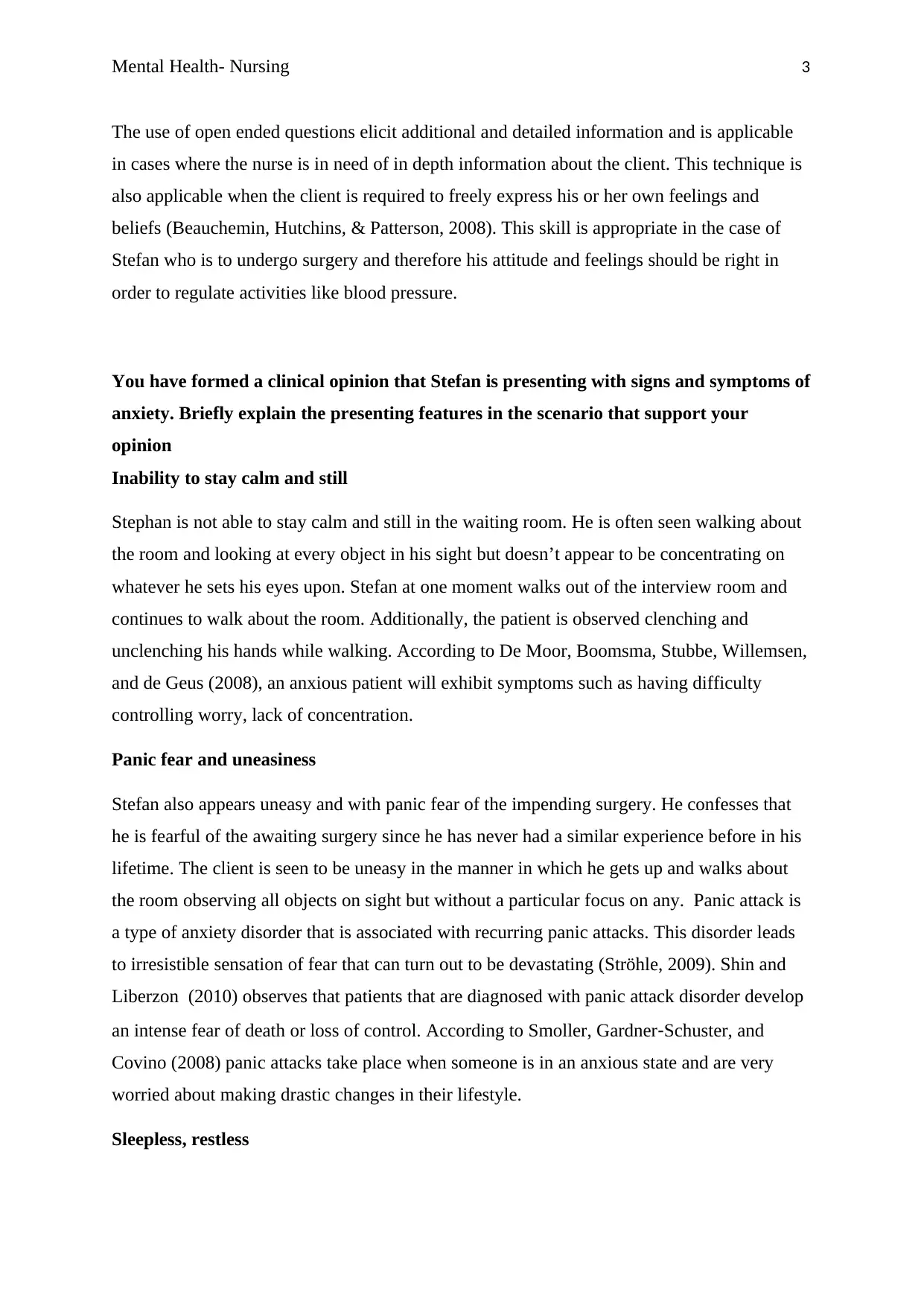
Mental Health- Nursing 3
The use of open ended questions elicit additional and detailed information and is applicable
in cases where the nurse is in need of in depth information about the client. This technique is
also applicable when the client is required to freely express his or her own feelings and
beliefs (Beauchemin, Hutchins, & Patterson, 2008). This skill is appropriate in the case of
Stefan who is to undergo surgery and therefore his attitude and feelings should be right in
order to regulate activities like blood pressure.
You have formed a clinical opinion that Stefan is presenting with signs and symptoms of
anxiety. Briefly explain the presenting features in the scenario that support your
opinion
Inability to stay calm and still
Stephan is not able to stay calm and still in the waiting room. He is often seen walking about
the room and looking at every object in his sight but doesn’t appear to be concentrating on
whatever he sets his eyes upon. Stefan at one moment walks out of the interview room and
continues to walk about the room. Additionally, the patient is observed clenching and
unclenching his hands while walking. According to De Moor, Boomsma, Stubbe, Willemsen,
and de Geus (2008), an anxious patient will exhibit symptoms such as having difficulty
controlling worry, lack of concentration.
Panic fear and uneasiness
Stefan also appears uneasy and with panic fear of the impending surgery. He confesses that
he is fearful of the awaiting surgery since he has never had a similar experience before in his
lifetime. The client is seen to be uneasy in the manner in which he gets up and walks about
the room observing all objects on sight but without a particular focus on any. Panic attack is
a type of anxiety disorder that is associated with recurring panic attacks. This disorder leads
to irresistible sensation of fear that can turn out to be devastating (Ströhle, 2009). Shin and
Liberzon (2010) observes that patients that are diagnosed with panic attack disorder develop
an intense fear of death or loss of control. According to Smoller, Gardner‐Schuster, and
Covino (2008) panic attacks take place when someone is in an anxious state and are very
worried about making drastic changes in their lifestyle.
Sleepless, restless
The use of open ended questions elicit additional and detailed information and is applicable
in cases where the nurse is in need of in depth information about the client. This technique is
also applicable when the client is required to freely express his or her own feelings and
beliefs (Beauchemin, Hutchins, & Patterson, 2008). This skill is appropriate in the case of
Stefan who is to undergo surgery and therefore his attitude and feelings should be right in
order to regulate activities like blood pressure.
You have formed a clinical opinion that Stefan is presenting with signs and symptoms of
anxiety. Briefly explain the presenting features in the scenario that support your
opinion
Inability to stay calm and still
Stephan is not able to stay calm and still in the waiting room. He is often seen walking about
the room and looking at every object in his sight but doesn’t appear to be concentrating on
whatever he sets his eyes upon. Stefan at one moment walks out of the interview room and
continues to walk about the room. Additionally, the patient is observed clenching and
unclenching his hands while walking. According to De Moor, Boomsma, Stubbe, Willemsen,
and de Geus (2008), an anxious patient will exhibit symptoms such as having difficulty
controlling worry, lack of concentration.
Panic fear and uneasiness
Stefan also appears uneasy and with panic fear of the impending surgery. He confesses that
he is fearful of the awaiting surgery since he has never had a similar experience before in his
lifetime. The client is seen to be uneasy in the manner in which he gets up and walks about
the room observing all objects on sight but without a particular focus on any. Panic attack is
a type of anxiety disorder that is associated with recurring panic attacks. This disorder leads
to irresistible sensation of fear that can turn out to be devastating (Ströhle, 2009). Shin and
Liberzon (2010) observes that patients that are diagnosed with panic attack disorder develop
an intense fear of death or loss of control. According to Smoller, Gardner‐Schuster, and
Covino (2008) panic attacks take place when someone is in an anxious state and are very
worried about making drastic changes in their lifestyle.
Sleepless, restless
⊘ This is a preview!⊘
Do you want full access?
Subscribe today to unlock all pages.

Trusted by 1+ million students worldwide
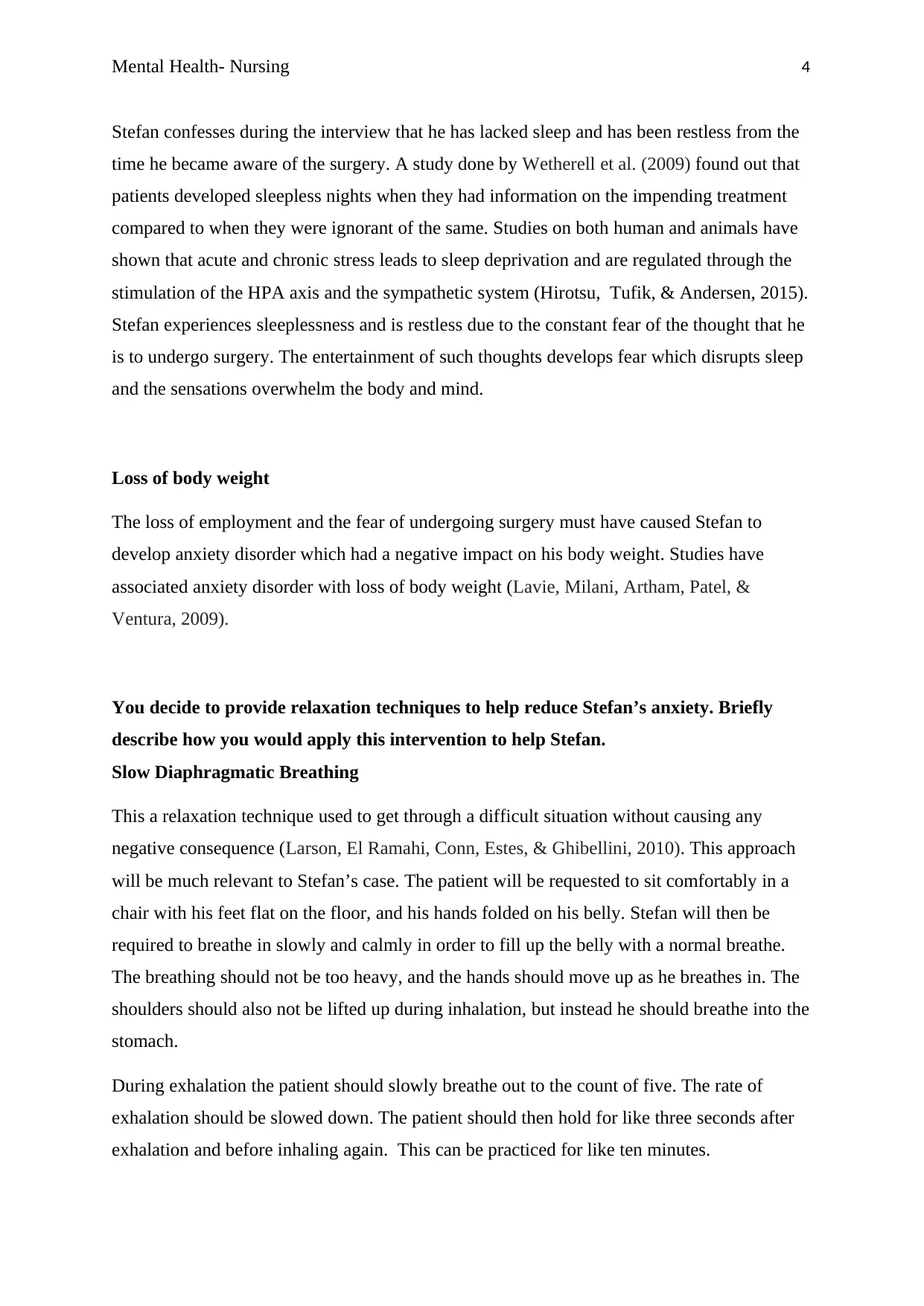
Mental Health- Nursing 4
Stefan confesses during the interview that he has lacked sleep and has been restless from the
time he became aware of the surgery. A study done by Wetherell et al. (2009) found out that
patients developed sleepless nights when they had information on the impending treatment
compared to when they were ignorant of the same. Studies on both human and animals have
shown that acute and chronic stress leads to sleep deprivation and are regulated through the
stimulation of the HPA axis and the sympathetic system (Hirotsu, Tufik, & Andersen, 2015).
Stefan experiences sleeplessness and is restless due to the constant fear of the thought that he
is to undergo surgery. The entertainment of such thoughts develops fear which disrupts sleep
and the sensations overwhelm the body and mind.
Loss of body weight
The loss of employment and the fear of undergoing surgery must have caused Stefan to
develop anxiety disorder which had a negative impact on his body weight. Studies have
associated anxiety disorder with loss of body weight (Lavie, Milani, Artham, Patel, &
Ventura, 2009).
You decide to provide relaxation techniques to help reduce Stefan’s anxiety. Briefly
describe how you would apply this intervention to help Stefan.
Slow Diaphragmatic Breathing
This a relaxation technique used to get through a difficult situation without causing any
negative consequence (Larson, El Ramahi, Conn, Estes, & Ghibellini, 2010). This approach
will be much relevant to Stefan’s case. The patient will be requested to sit comfortably in a
chair with his feet flat on the floor, and his hands folded on his belly. Stefan will then be
required to breathe in slowly and calmly in order to fill up the belly with a normal breathe.
The breathing should not be too heavy, and the hands should move up as he breathes in. The
shoulders should also not be lifted up during inhalation, but instead he should breathe into the
stomach.
During exhalation the patient should slowly breathe out to the count of five. The rate of
exhalation should be slowed down. The patient should then hold for like three seconds after
exhalation and before inhaling again. This can be practiced for like ten minutes.
Stefan confesses during the interview that he has lacked sleep and has been restless from the
time he became aware of the surgery. A study done by Wetherell et al. (2009) found out that
patients developed sleepless nights when they had information on the impending treatment
compared to when they were ignorant of the same. Studies on both human and animals have
shown that acute and chronic stress leads to sleep deprivation and are regulated through the
stimulation of the HPA axis and the sympathetic system (Hirotsu, Tufik, & Andersen, 2015).
Stefan experiences sleeplessness and is restless due to the constant fear of the thought that he
is to undergo surgery. The entertainment of such thoughts develops fear which disrupts sleep
and the sensations overwhelm the body and mind.
Loss of body weight
The loss of employment and the fear of undergoing surgery must have caused Stefan to
develop anxiety disorder which had a negative impact on his body weight. Studies have
associated anxiety disorder with loss of body weight (Lavie, Milani, Artham, Patel, &
Ventura, 2009).
You decide to provide relaxation techniques to help reduce Stefan’s anxiety. Briefly
describe how you would apply this intervention to help Stefan.
Slow Diaphragmatic Breathing
This a relaxation technique used to get through a difficult situation without causing any
negative consequence (Larson, El Ramahi, Conn, Estes, & Ghibellini, 2010). This approach
will be much relevant to Stefan’s case. The patient will be requested to sit comfortably in a
chair with his feet flat on the floor, and his hands folded on his belly. Stefan will then be
required to breathe in slowly and calmly in order to fill up the belly with a normal breathe.
The breathing should not be too heavy, and the hands should move up as he breathes in. The
shoulders should also not be lifted up during inhalation, but instead he should breathe into the
stomach.
During exhalation the patient should slowly breathe out to the count of five. The rate of
exhalation should be slowed down. The patient should then hold for like three seconds after
exhalation and before inhaling again. This can be practiced for like ten minutes.
Paraphrase This Document
Need a fresh take? Get an instant paraphrase of this document with our AI Paraphraser
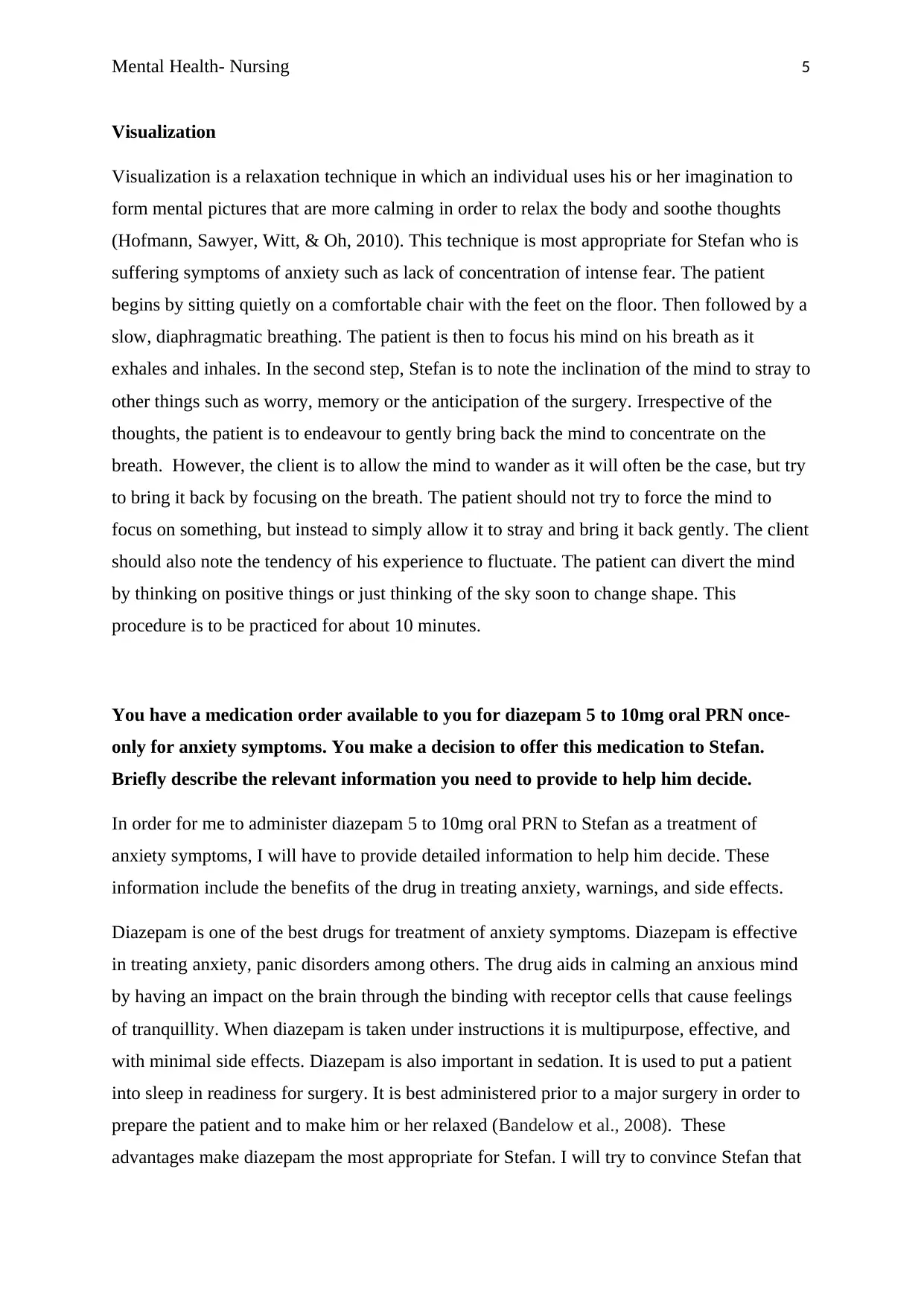
Mental Health- Nursing 5
Visualization
Visualization is a relaxation technique in which an individual uses his or her imagination to
form mental pictures that are more calming in order to relax the body and soothe thoughts
(Hofmann, Sawyer, Witt, & Oh, 2010). This technique is most appropriate for Stefan who is
suffering symptoms of anxiety such as lack of concentration of intense fear. The patient
begins by sitting quietly on a comfortable chair with the feet on the floor. Then followed by a
slow, diaphragmatic breathing. The patient is then to focus his mind on his breath as it
exhales and inhales. In the second step, Stefan is to note the inclination of the mind to stray to
other things such as worry, memory or the anticipation of the surgery. Irrespective of the
thoughts, the patient is to endeavour to gently bring back the mind to concentrate on the
breath. However, the client is to allow the mind to wander as it will often be the case, but try
to bring it back by focusing on the breath. The patient should not try to force the mind to
focus on something, but instead to simply allow it to stray and bring it back gently. The client
should also note the tendency of his experience to fluctuate. The patient can divert the mind
by thinking on positive things or just thinking of the sky soon to change shape. This
procedure is to be practiced for about 10 minutes.
You have a medication order available to you for diazepam 5 to 10mg oral PRN once-
only for anxiety symptoms. You make a decision to offer this medication to Stefan.
Briefly describe the relevant information you need to provide to help him decide.
In order for me to administer diazepam 5 to 10mg oral PRN to Stefan as a treatment of
anxiety symptoms, I will have to provide detailed information to help him decide. These
information include the benefits of the drug in treating anxiety, warnings, and side effects.
Diazepam is one of the best drugs for treatment of anxiety symptoms. Diazepam is effective
in treating anxiety, panic disorders among others. The drug aids in calming an anxious mind
by having an impact on the brain through the binding with receptor cells that cause feelings
of tranquillity. When diazepam is taken under instructions it is multipurpose, effective, and
with minimal side effects. Diazepam is also important in sedation. It is used to put a patient
into sleep in readiness for surgery. It is best administered prior to a major surgery in order to
prepare the patient and to make him or her relaxed (Bandelow et al., 2008). These
advantages make diazepam the most appropriate for Stefan. I will try to convince Stefan that
Visualization
Visualization is a relaxation technique in which an individual uses his or her imagination to
form mental pictures that are more calming in order to relax the body and soothe thoughts
(Hofmann, Sawyer, Witt, & Oh, 2010). This technique is most appropriate for Stefan who is
suffering symptoms of anxiety such as lack of concentration of intense fear. The patient
begins by sitting quietly on a comfortable chair with the feet on the floor. Then followed by a
slow, diaphragmatic breathing. The patient is then to focus his mind on his breath as it
exhales and inhales. In the second step, Stefan is to note the inclination of the mind to stray to
other things such as worry, memory or the anticipation of the surgery. Irrespective of the
thoughts, the patient is to endeavour to gently bring back the mind to concentrate on the
breath. However, the client is to allow the mind to wander as it will often be the case, but try
to bring it back by focusing on the breath. The patient should not try to force the mind to
focus on something, but instead to simply allow it to stray and bring it back gently. The client
should also note the tendency of his experience to fluctuate. The patient can divert the mind
by thinking on positive things or just thinking of the sky soon to change shape. This
procedure is to be practiced for about 10 minutes.
You have a medication order available to you for diazepam 5 to 10mg oral PRN once-
only for anxiety symptoms. You make a decision to offer this medication to Stefan.
Briefly describe the relevant information you need to provide to help him decide.
In order for me to administer diazepam 5 to 10mg oral PRN to Stefan as a treatment of
anxiety symptoms, I will have to provide detailed information to help him decide. These
information include the benefits of the drug in treating anxiety, warnings, and side effects.
Diazepam is one of the best drugs for treatment of anxiety symptoms. Diazepam is effective
in treating anxiety, panic disorders among others. The drug aids in calming an anxious mind
by having an impact on the brain through the binding with receptor cells that cause feelings
of tranquillity. When diazepam is taken under instructions it is multipurpose, effective, and
with minimal side effects. Diazepam is also important in sedation. It is used to put a patient
into sleep in readiness for surgery. It is best administered prior to a major surgery in order to
prepare the patient and to make him or her relaxed (Bandelow et al., 2008). These
advantages make diazepam the most appropriate for Stefan. I will try to convince Stefan that
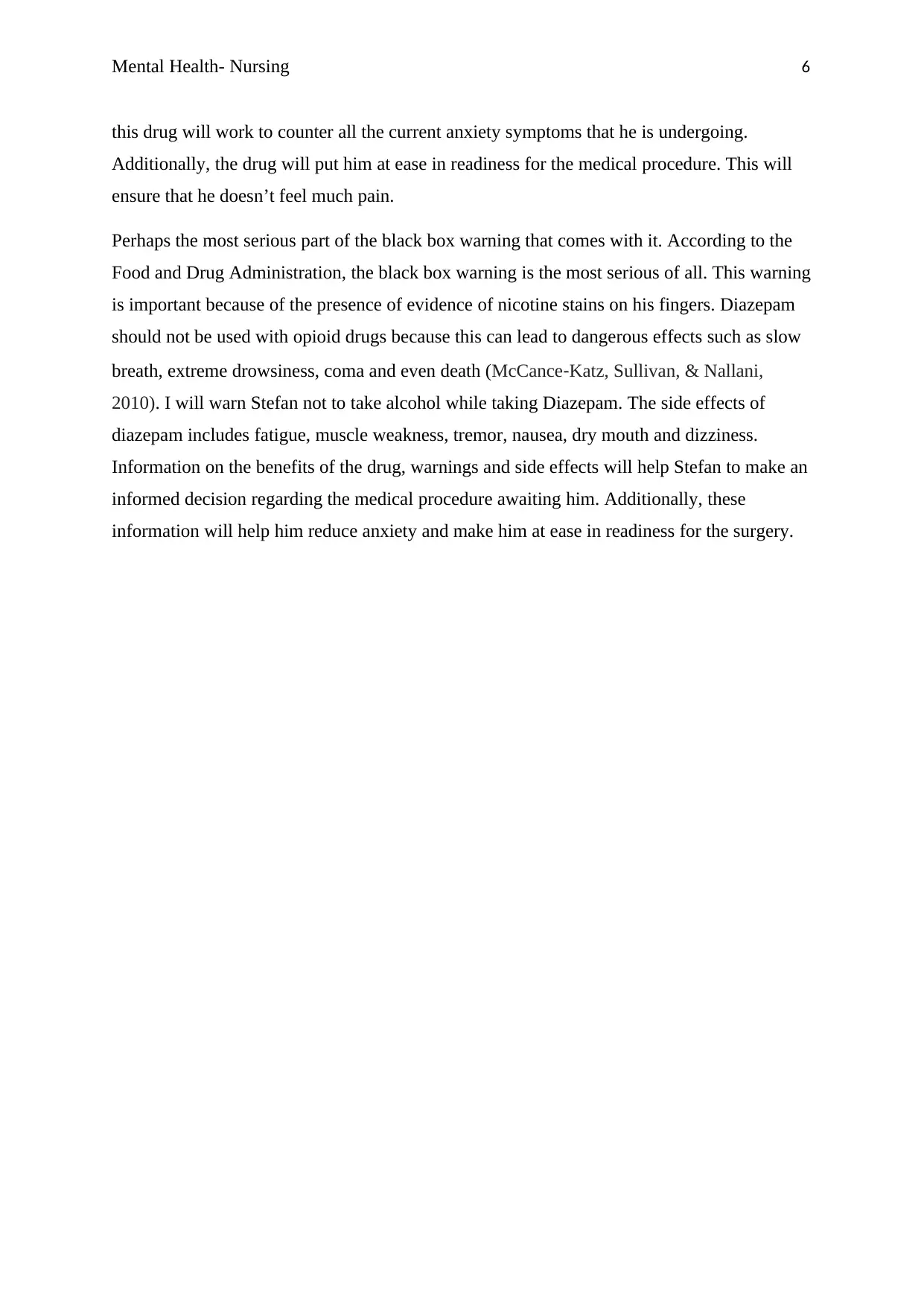
Mental Health- Nursing 6
this drug will work to counter all the current anxiety symptoms that he is undergoing.
Additionally, the drug will put him at ease in readiness for the medical procedure. This will
ensure that he doesn’t feel much pain.
Perhaps the most serious part of the black box warning that comes with it. According to the
Food and Drug Administration, the black box warning is the most serious of all. This warning
is important because of the presence of evidence of nicotine stains on his fingers. Diazepam
should not be used with opioid drugs because this can lead to dangerous effects such as slow
breath, extreme drowsiness, coma and even death (McCance‐Katz, Sullivan, & Nallani,
2010). I will warn Stefan not to take alcohol while taking Diazepam. The side effects of
diazepam includes fatigue, muscle weakness, tremor, nausea, dry mouth and dizziness.
Information on the benefits of the drug, warnings and side effects will help Stefan to make an
informed decision regarding the medical procedure awaiting him. Additionally, these
information will help him reduce anxiety and make him at ease in readiness for the surgery.
this drug will work to counter all the current anxiety symptoms that he is undergoing.
Additionally, the drug will put him at ease in readiness for the medical procedure. This will
ensure that he doesn’t feel much pain.
Perhaps the most serious part of the black box warning that comes with it. According to the
Food and Drug Administration, the black box warning is the most serious of all. This warning
is important because of the presence of evidence of nicotine stains on his fingers. Diazepam
should not be used with opioid drugs because this can lead to dangerous effects such as slow
breath, extreme drowsiness, coma and even death (McCance‐Katz, Sullivan, & Nallani,
2010). I will warn Stefan not to take alcohol while taking Diazepam. The side effects of
diazepam includes fatigue, muscle weakness, tremor, nausea, dry mouth and dizziness.
Information on the benefits of the drug, warnings and side effects will help Stefan to make an
informed decision regarding the medical procedure awaiting him. Additionally, these
information will help him reduce anxiety and make him at ease in readiness for the surgery.
⊘ This is a preview!⊘
Do you want full access?
Subscribe today to unlock all pages.

Trusted by 1+ million students worldwide
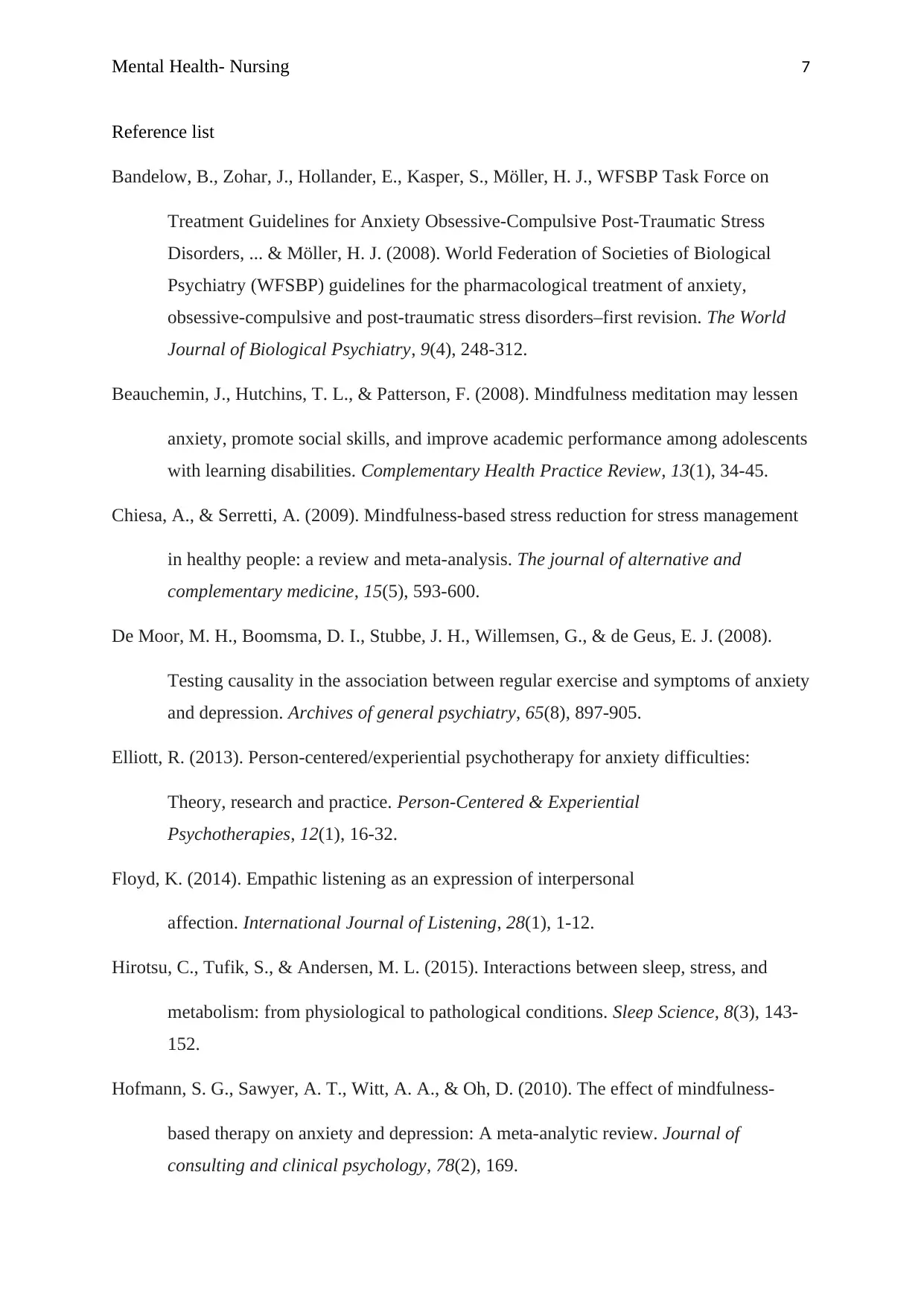
Mental Health- Nursing 7
Reference list
Bandelow, B., Zohar, J., Hollander, E., Kasper, S., Möller, H. J., WFSBP Task Force on
Treatment Guidelines for Anxiety Obsessive-Compulsive Post-Traumatic Stress
Disorders, ... & Möller, H. J. (2008). World Federation of Societies of Biological
Psychiatry (WFSBP) guidelines for the pharmacological treatment of anxiety,
obsessive-compulsive and post-traumatic stress disorders–first revision. The World
Journal of Biological Psychiatry, 9(4), 248-312.
Beauchemin, J., Hutchins, T. L., & Patterson, F. (2008). Mindfulness meditation may lessen
anxiety, promote social skills, and improve academic performance among adolescents
with learning disabilities. Complementary Health Practice Review, 13(1), 34-45.
Chiesa, A., & Serretti, A. (2009). Mindfulness-based stress reduction for stress management
in healthy people: a review and meta-analysis. The journal of alternative and
complementary medicine, 15(5), 593-600.
De Moor, M. H., Boomsma, D. I., Stubbe, J. H., Willemsen, G., & de Geus, E. J. (2008).
Testing causality in the association between regular exercise and symptoms of anxiety
and depression. Archives of general psychiatry, 65(8), 897-905.
Elliott, R. (2013). Person-centered/experiential psychotherapy for anxiety difficulties:
Theory, research and practice. Person-Centered & Experiential
Psychotherapies, 12(1), 16-32.
Floyd, K. (2014). Empathic listening as an expression of interpersonal
affection. International Journal of Listening, 28(1), 1-12.
Hirotsu, C., Tufik, S., & Andersen, M. L. (2015). Interactions between sleep, stress, and
metabolism: from physiological to pathological conditions. Sleep Science, 8(3), 143-
152.
Hofmann, S. G., Sawyer, A. T., Witt, A. A., & Oh, D. (2010). The effect of mindfulness-
based therapy on anxiety and depression: A meta-analytic review. Journal of
consulting and clinical psychology, 78(2), 169.
Reference list
Bandelow, B., Zohar, J., Hollander, E., Kasper, S., Möller, H. J., WFSBP Task Force on
Treatment Guidelines for Anxiety Obsessive-Compulsive Post-Traumatic Stress
Disorders, ... & Möller, H. J. (2008). World Federation of Societies of Biological
Psychiatry (WFSBP) guidelines for the pharmacological treatment of anxiety,
obsessive-compulsive and post-traumatic stress disorders–first revision. The World
Journal of Biological Psychiatry, 9(4), 248-312.
Beauchemin, J., Hutchins, T. L., & Patterson, F. (2008). Mindfulness meditation may lessen
anxiety, promote social skills, and improve academic performance among adolescents
with learning disabilities. Complementary Health Practice Review, 13(1), 34-45.
Chiesa, A., & Serretti, A. (2009). Mindfulness-based stress reduction for stress management
in healthy people: a review and meta-analysis. The journal of alternative and
complementary medicine, 15(5), 593-600.
De Moor, M. H., Boomsma, D. I., Stubbe, J. H., Willemsen, G., & de Geus, E. J. (2008).
Testing causality in the association between regular exercise and symptoms of anxiety
and depression. Archives of general psychiatry, 65(8), 897-905.
Elliott, R. (2013). Person-centered/experiential psychotherapy for anxiety difficulties:
Theory, research and practice. Person-Centered & Experiential
Psychotherapies, 12(1), 16-32.
Floyd, K. (2014). Empathic listening as an expression of interpersonal
affection. International Journal of Listening, 28(1), 1-12.
Hirotsu, C., Tufik, S., & Andersen, M. L. (2015). Interactions between sleep, stress, and
metabolism: from physiological to pathological conditions. Sleep Science, 8(3), 143-
152.
Hofmann, S. G., Sawyer, A. T., Witt, A. A., & Oh, D. (2010). The effect of mindfulness-
based therapy on anxiety and depression: A meta-analytic review. Journal of
consulting and clinical psychology, 78(2), 169.
Paraphrase This Document
Need a fresh take? Get an instant paraphrase of this document with our AI Paraphraser
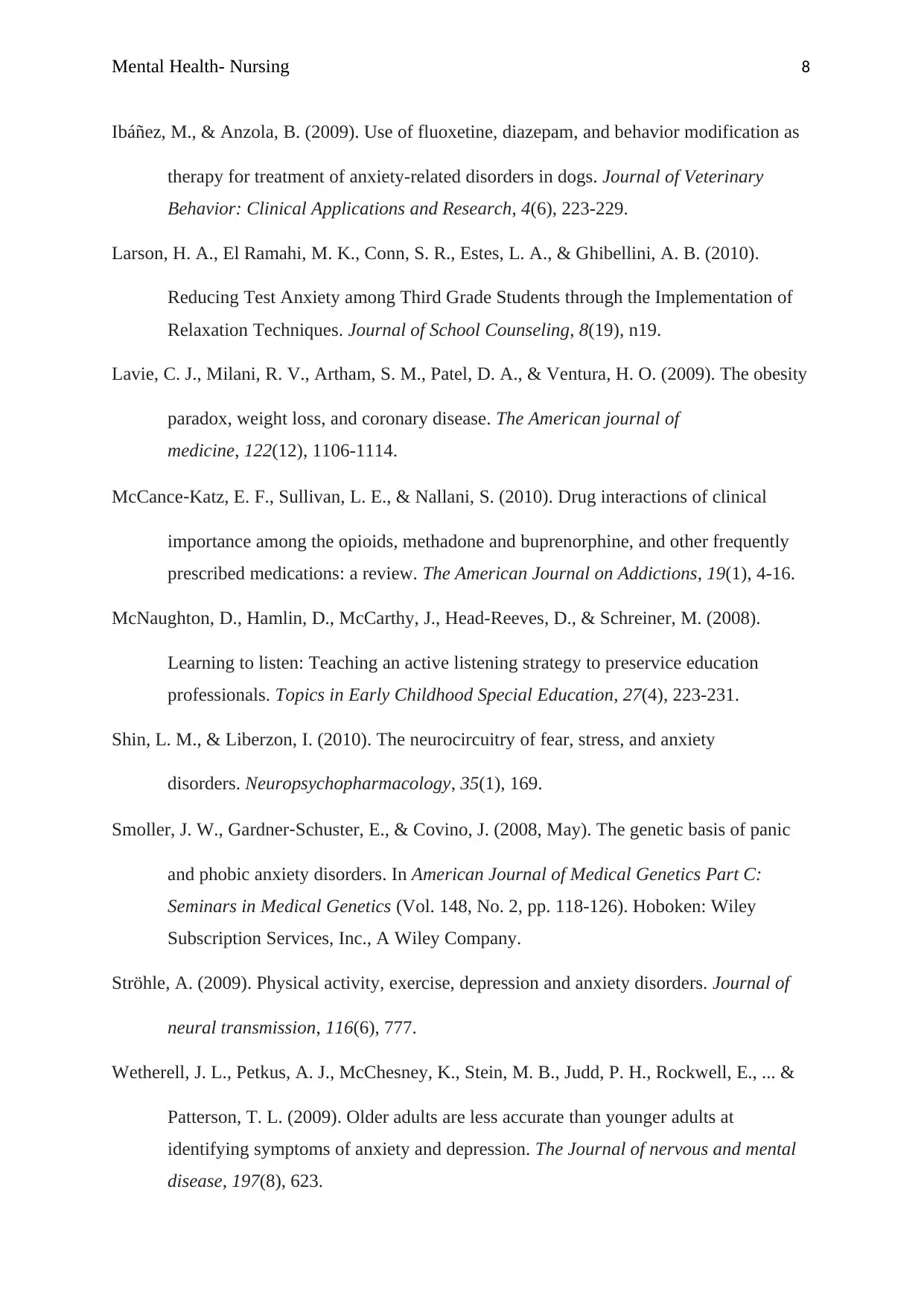
Mental Health- Nursing 8
Ibáñez, M., & Anzola, B. (2009). Use of fluoxetine, diazepam, and behavior modification as
therapy for treatment of anxiety-related disorders in dogs. Journal of Veterinary
Behavior: Clinical Applications and Research, 4(6), 223-229.
Larson, H. A., El Ramahi, M. K., Conn, S. R., Estes, L. A., & Ghibellini, A. B. (2010).
Reducing Test Anxiety among Third Grade Students through the Implementation of
Relaxation Techniques. Journal of School Counseling, 8(19), n19.
Lavie, C. J., Milani, R. V., Artham, S. M., Patel, D. A., & Ventura, H. O. (2009). The obesity
paradox, weight loss, and coronary disease. The American journal of
medicine, 122(12), 1106-1114.
McCance‐Katz, E. F., Sullivan, L. E., & Nallani, S. (2010). Drug interactions of clinical
importance among the opioids, methadone and buprenorphine, and other frequently
prescribed medications: a review. The American Journal on Addictions, 19(1), 4-16.
McNaughton, D., Hamlin, D., McCarthy, J., Head-Reeves, D., & Schreiner, M. (2008).
Learning to listen: Teaching an active listening strategy to preservice education
professionals. Topics in Early Childhood Special Education, 27(4), 223-231.
Shin, L. M., & Liberzon, I. (2010). The neurocircuitry of fear, stress, and anxiety
disorders. Neuropsychopharmacology, 35(1), 169.
Smoller, J. W., Gardner‐Schuster, E., & Covino, J. (2008, May). The genetic basis of panic
and phobic anxiety disorders. In American Journal of Medical Genetics Part C:
Seminars in Medical Genetics (Vol. 148, No. 2, pp. 118-126). Hoboken: Wiley
Subscription Services, Inc., A Wiley Company.
Ströhle, A. (2009). Physical activity, exercise, depression and anxiety disorders. Journal of
neural transmission, 116(6), 777.
Wetherell, J. L., Petkus, A. J., McChesney, K., Stein, M. B., Judd, P. H., Rockwell, E., ... &
Patterson, T. L. (2009). Older adults are less accurate than younger adults at
identifying symptoms of anxiety and depression. The Journal of nervous and mental
disease, 197(8), 623.
Ibáñez, M., & Anzola, B. (2009). Use of fluoxetine, diazepam, and behavior modification as
therapy for treatment of anxiety-related disorders in dogs. Journal of Veterinary
Behavior: Clinical Applications and Research, 4(6), 223-229.
Larson, H. A., El Ramahi, M. K., Conn, S. R., Estes, L. A., & Ghibellini, A. B. (2010).
Reducing Test Anxiety among Third Grade Students through the Implementation of
Relaxation Techniques. Journal of School Counseling, 8(19), n19.
Lavie, C. J., Milani, R. V., Artham, S. M., Patel, D. A., & Ventura, H. O. (2009). The obesity
paradox, weight loss, and coronary disease. The American journal of
medicine, 122(12), 1106-1114.
McCance‐Katz, E. F., Sullivan, L. E., & Nallani, S. (2010). Drug interactions of clinical
importance among the opioids, methadone and buprenorphine, and other frequently
prescribed medications: a review. The American Journal on Addictions, 19(1), 4-16.
McNaughton, D., Hamlin, D., McCarthy, J., Head-Reeves, D., & Schreiner, M. (2008).
Learning to listen: Teaching an active listening strategy to preservice education
professionals. Topics in Early Childhood Special Education, 27(4), 223-231.
Shin, L. M., & Liberzon, I. (2010). The neurocircuitry of fear, stress, and anxiety
disorders. Neuropsychopharmacology, 35(1), 169.
Smoller, J. W., Gardner‐Schuster, E., & Covino, J. (2008, May). The genetic basis of panic
and phobic anxiety disorders. In American Journal of Medical Genetics Part C:
Seminars in Medical Genetics (Vol. 148, No. 2, pp. 118-126). Hoboken: Wiley
Subscription Services, Inc., A Wiley Company.
Ströhle, A. (2009). Physical activity, exercise, depression and anxiety disorders. Journal of
neural transmission, 116(6), 777.
Wetherell, J. L., Petkus, A. J., McChesney, K., Stein, M. B., Judd, P. H., Rockwell, E., ... &
Patterson, T. L. (2009). Older adults are less accurate than younger adults at
identifying symptoms of anxiety and depression. The Journal of nervous and mental
disease, 197(8), 623.
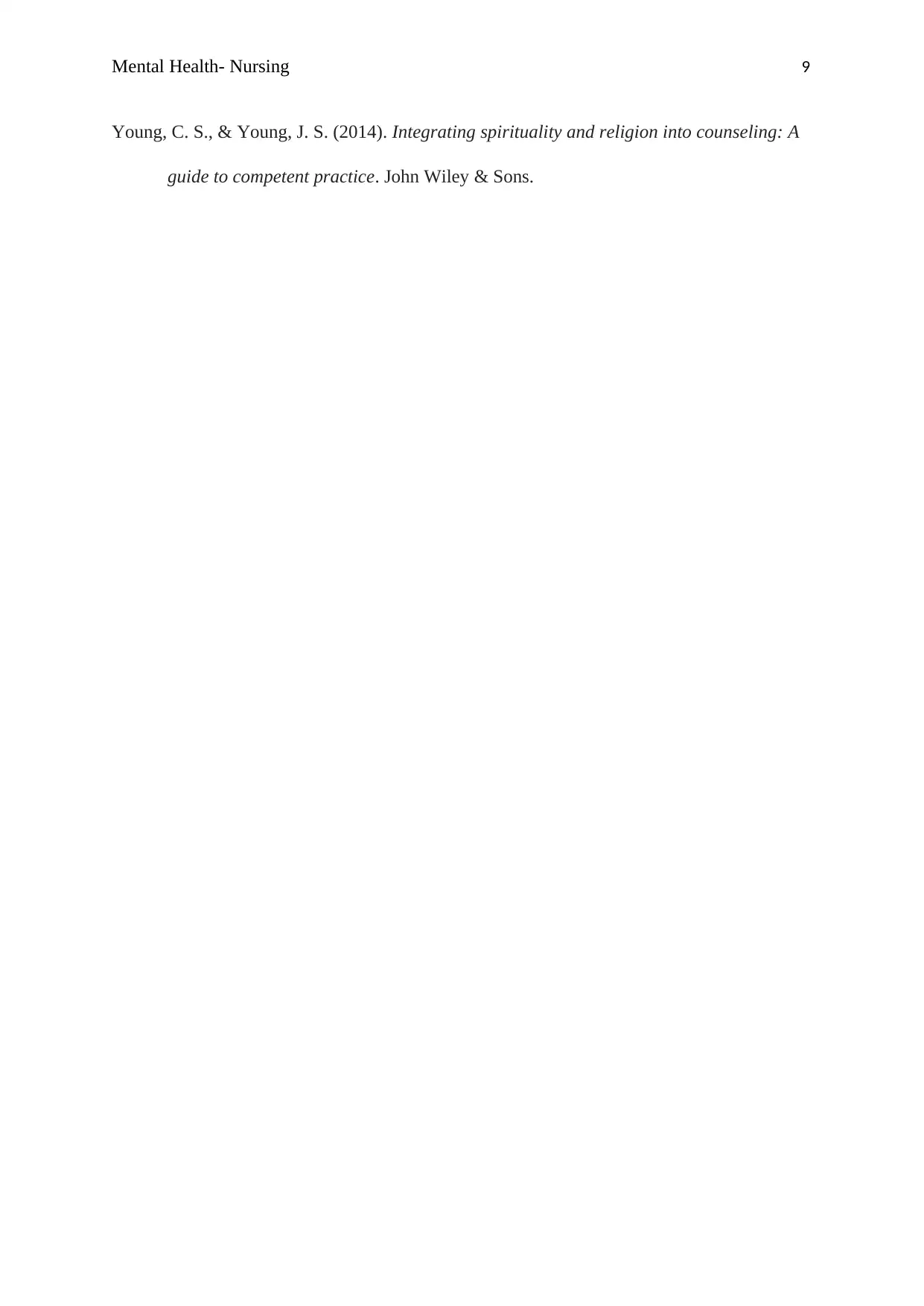
Mental Health- Nursing 9
Young, C. S., & Young, J. S. (2014). Integrating spirituality and religion into counseling: A
guide to competent practice. John Wiley & Sons.
Young, C. S., & Young, J. S. (2014). Integrating spirituality and religion into counseling: A
guide to competent practice. John Wiley & Sons.
⊘ This is a preview!⊘
Do you want full access?
Subscribe today to unlock all pages.

Trusted by 1+ million students worldwide
1 out of 9
Related Documents
Your All-in-One AI-Powered Toolkit for Academic Success.
+13062052269
info@desklib.com
Available 24*7 on WhatsApp / Email
![[object Object]](/_next/static/media/star-bottom.7253800d.svg)
Unlock your academic potential
Copyright © 2020–2025 A2Z Services. All Rights Reserved. Developed and managed by ZUCOL.





